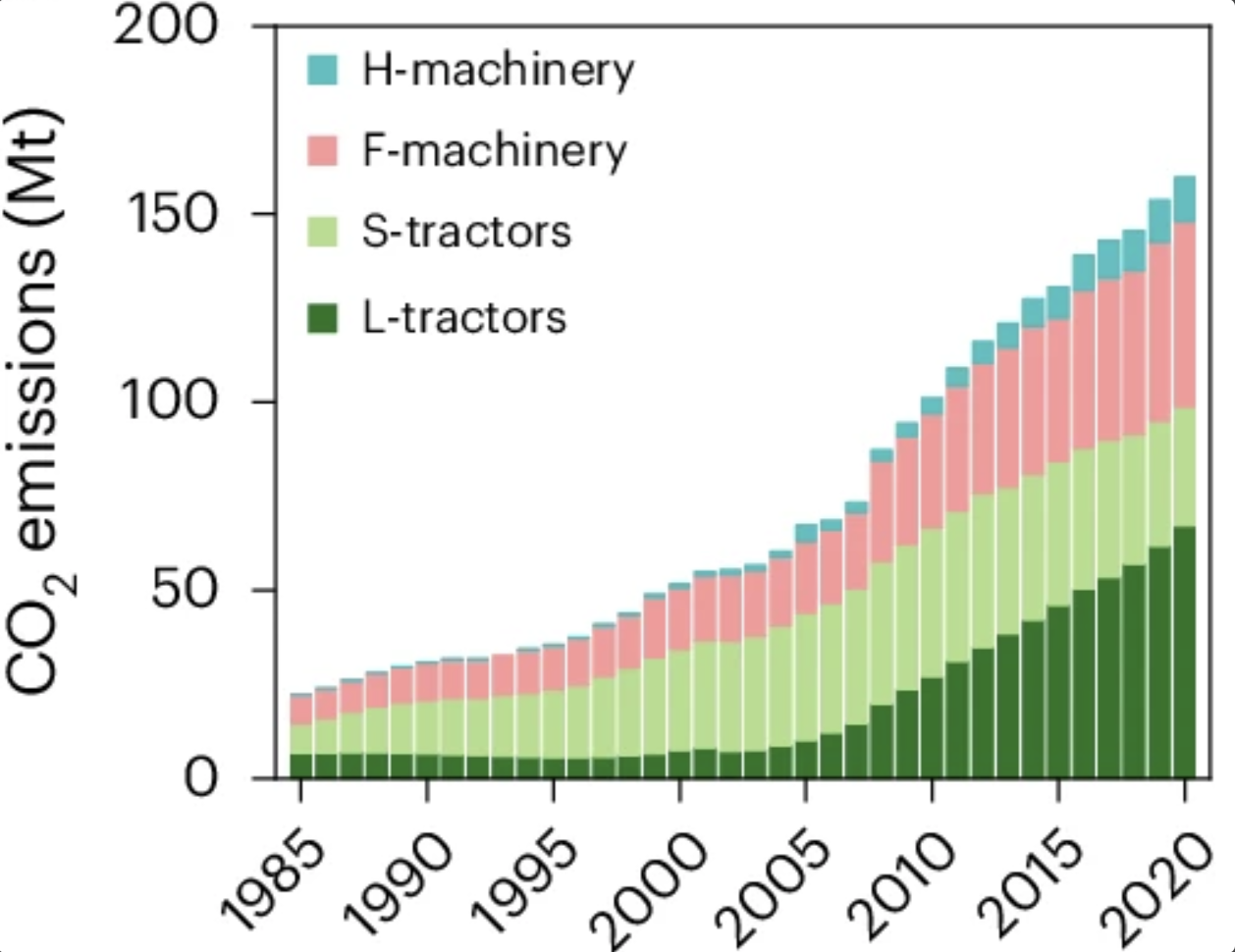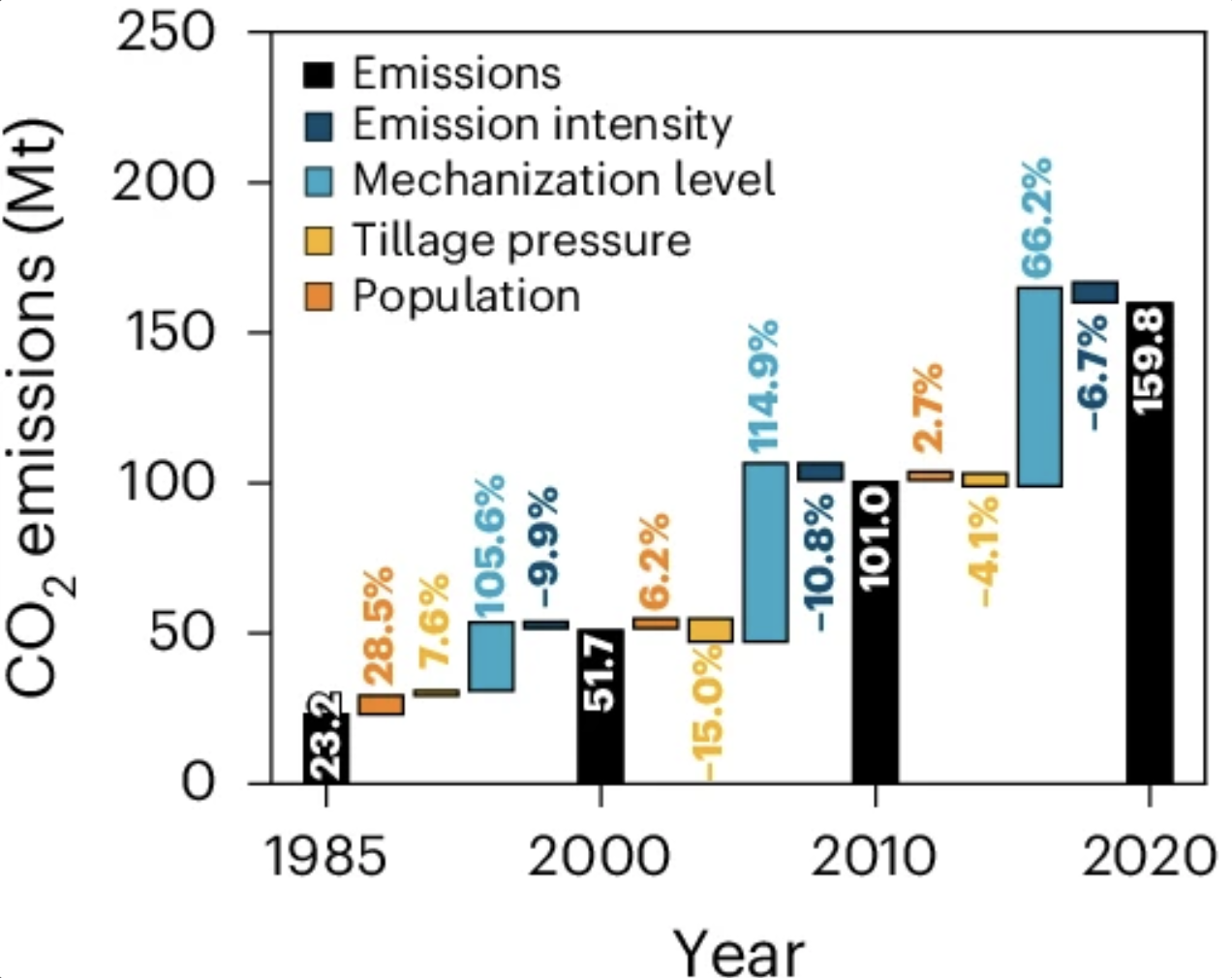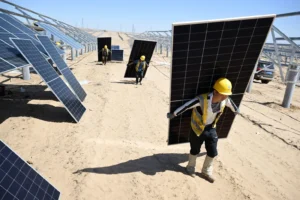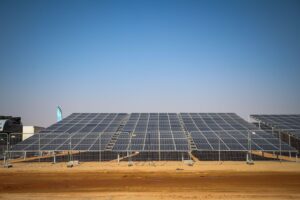新研究显示,中国来自农业机械的碳排放快速增长,可能会“阻碍”该国实现净零排放的目标。
这项发表在《自然-食品》(Nature Food)期刊上的研究发现,自1985年以来,中国农业机械CO2(二氧化碳)排放量增加了大约七倍。
研究人员利用政府发布的不同时期农机数量统计数据,计算了1985年至2020年期间CO2排放量及其他空气污染物的变化。
他们发现,自1985年以来,农业机械的CO2排放量平均每年增长近6%。
研究指出,按照中国实现2060年净零排放目标的路径,若农业机械化程度按“预期趋势”继续提升,其相关排放在2050年可能占中国总排放量的21%。

作者表示,这可能会使中国实现减排目标更加困难,并导致空气质量“恶化”。
然而,研究还发现,如果广泛采用由可再生能源驱动的农业机械,有望减少65%至70%的相关排放。
一位未参与该研究的专家对Carbon Brief表示,尽管该研究“具有价值”,但农业机械不太可能在总排放量中占到如此高的比例。
“如果中国在减少其他排放源方面取得了快速进展……那么我预计在农业机械的脱碳方面也会取得显著成效。”她说。
农机相关排放
粮食系统大约占人类温室气体排放的三分之一。
这一数字涵盖了与粮食生产相关的所有排放——从因森林砍伐或土地使用变化导致的排放,到奶牛打嗝或粪便释放的甲烷。
这项新研究的数据来自《中国统计年鉴》,后者提供了各种社会经济指标的年度统计数据。研究者从中提取了中国农业机械的数量与功率、机械所用的燃料属性、耕地面积、人口等信息。
除了CO2排放量外,研究者还计算了三种与农业机械相关的空气污染物排放量:PM2.5(细颗粒物)、NOx(氮氧化物)和THC(总烃)。
研究者将农业机械分为四类:小型拖拉机、大型拖拉机、田间管理机械和收割机械。然后,他们计算了每类机械在每一年的CO2、PM2.5、NOx和THC排放量。
下图展示了1985年至2020年研究期间的CO2排放量。图中柱状表示不同类型农业机械的排放量:收割机械(浅蓝色)、田间管理机械(粉色)、小型拖拉机(浅绿色)和大型拖拉机(深绿色)。

他们发现,农业机械CO2排放总量已从1985年的约23MtCO2(1MtCO2=百万吨二氧化碳),增长到2020年的近160MtCO2,年均增长率为5.7%。
这相当于2020年中国总排放量的约1.5%。虽然比例不高,但作者指出,这一排放量实际上超过了部分国家的年排放总量,如荷兰、菲律宾和尼日利亚。
尤其是,大型拖拉机所带来的排放量自2005年以来平稳增长,作者将此归因于“一系列推动大型机械化的政策”。
未参与该研究的中山大学教授覃章才表示,该研究将农业机械排放从更广泛的食品系统中拆分出来“提供了独特的视角”。覃教授表示,该做法“使政策制定者能够在不影响农业生产力的情况下,设计有针对性的干预措施”。
区域分布
研究者还将排放数据细化到省级层面,发现不同地区农业机械排放量差异很大。排放量最低省份仅有约0.1MtCO2,而排放最高的省份则达到17.5MtCO2。
他们发现,中国东部和东北的五个省份——山东、河南、黑龙江、河北和安徽,占农业机械排放总量的40%以上。这些省份合计拥有全国三分之一的耕地面积和约46%的农机总动力。
然而,即使在这些高排放地区之间,机械类型的构成也存在差异,有些省份更依赖大型拖拉机,有些则以田间管理机械为主。
未参与该研究的《Our World in Data》副主编汉娜·里奇(Hannah Ritchie)博士表示,这种次国家级排放分析是该研究的关键进展之一。
里奇博士解释说:“这种排放估算的空间分辨率极具价值,因为在中国这样幅员辽阔的国家,各地排放差异显著。它还为未来在不同机械化程度和低碳技术采纳率下的潜在排放路径,提供了重要的洞见。”
增长因素
研究人员确定了四个推动排放增加的社会经济因素:人口增长、人均耕地面积变化、机械化水平以及排放强度。
下图展示了由排放强度(深蓝色)、机械化水平(浅蓝色)、人均耕地面积(黄色)和人口(橙色)的变化所导致的CO2排放量变化(黑色)。

论文指出,在这些因素中,机械化水平的提升“主导”了排放变化。仅这些变化就导致1985年至2000年间排放量增加了约100%。
研究指出,人口增长也是研究区间早期农业机械排放量增长的重要驱动力,但自2000年以来,这一因素的影响有所减弱。
相比之下,作者指出,排放强度的上升总体上反而促使排放减少;而“耕作压力”在研究初期推动了排放上升,但自2000年起则转而起到抑制排放的作用。
碳排放目标
作者指出,根据现行政策,中国致力于“到2035年主要农作物生产实现全过程机械化”。
因此,他们警告称,若农业机械化持续增长且未加遏制,可能会对中国实现“双碳”目标构成挑战。(“双碳”目标指的是中国承诺在2030年前实现碳达峰,并在2060年前实现碳中和。)
作者指出,有效减排需在短期和长期分别采取不同策略,并强调从短期可用性来看,“生物燃料和天然气将在未来十年发挥重要作用”。
作者还认为,从长远来看,可再生能源以及绿氢“具有最大的减排潜力”。
此前研究表明,使用自动化设备、电动拖拉机和可再生能源可以减少90%的农业排放。
里奇表示,她“对农业机械的相对(排放量占比)在2050年能达到20%持一定怀疑态度”。
她补充道:“这基于一个假设,即这些排放大多不会减少,而其他大多数行业排放迅速下降。但如果中国在减少其他排放源,包括卡车等更大型的道路运输排放和其他农业排放方面取得快速进展……那么我预计在农业机械的脱碳方面也会取得显著成效。”
The post 中国农机排放量上升或“阻碍”净零目标实现 appeared first on Carbon Brief.
https://www.carbonbrief.org/translations-rising-emissions-from-farm-equipment-could-hinder-chinas-net-zero-goals/
Climate Change
DeBriefed 15 August 2025: Raging wildfires; Xi’s priorities; Factchecking the Trump climate report
Welcome to Carbon Brief’s DeBriefed.
An essential guide to the week’s key developments relating to climate change.
This week
Blazing heat hits Europe
FANNING THE FLAMES: Wildfires “fanned by a heatwave and strong winds” caused havoc across southern Europe, Reuters reported. It added: “Fire has affected nearly 440,000 hectares (1,700 square miles) in the eurozone so far in 2025, double the average for the same period of the year since 2006.” Extreme heat is “breaking temperature records across Europe”, the Guardian said, with several countries reporting readings of around 40C.
HUMAN TOLL: At least three people have died in the wildfires erupting across Spain, Turkey and Albania, France24 said, adding that the fires have “displaced thousands in Greece and Albania”. Le Monde reported that a child in Italy “died of heatstroke”, while thousands were evacuated from Spain and firefighters “battled three large wildfires” in Portugal.
UK WILDFIRE RISK: The UK saw temperatures as high as 33.4C this week as England “entered its fourth heatwave”, BBC News said. The high heat is causing “nationally significant” water shortfalls, it added, “hitting farms, damaging wildlife and increasing wildfires”. The Daily Mirror noted that these conditions “could last until mid-autumn”. Scientists warn the UK faces possible “firewaves” due to climate change, BBC News also reported.
Around the world
- GRID PRESSURES: Iraq suffered a “near nationwide blackout” as elevated power demand – due to extreme temperatures of around 50C – triggered a transmission line failure, Bloomberg reported.
- ‘DIRE’ DOWN UNDER: The Australian government is keeping a climate risk assessment that contains “dire” implications for the continent “under wraps”, the Australian Financial Review said.
- EXTREME RAINFALL: Mexico City is “seeing one of its heaviest rainy seasons in years”, the Washington Post said. Downpours in the Japanese island of Kyushu “caused flooding and mudslides”, according to Politico. In Kashmir, flash floods killed 56 and left “scores missing”, the Associated Press said.
- SOUTH-SOUTH COOPERATION: China and Brazil agreed to “ensure the success” of COP30 in a recent phone call, Chinese state news agency Xinhua reported.
- PLASTIC ‘DEADLOCK’: Talks on a plastic pollution treaty have failed again at a summit in Geneva, according to the Guardian, with countries “deadlocked” on whether it should include “curbs on production and toxic chemicals”.
15
The number of times by which the most ethnically-diverse areas in England are more likely to experience extreme heat than its “least diverse” areas, according to new analysis by Carbon Brief.
Latest climate research
- As many as 13 minerals critical for low-carbon energy may face shortages under 2C pathways | Nature Climate Change
- A “scoping review” examined the impact of climate change on poor sexual and reproductive health and rights in sub-Saharan Africa | PLOS One
- A UK university cut the carbon footprint of its weekly canteen menu by 31% “without students noticing” | Nature Food
(For more, see Carbon Brief’s in-depth daily summaries of the top climate news stories on Monday, Tuesday, Wednesday, Thursday and Friday.)
Captured
Factchecking Trump’s climate report

A report commissioned by the US government to justify rolling back climate regulations contains “at least 100 false or misleading statements”, according to a Carbon Brief factcheck involving dozens of leading climate scientists. The report, compiled in two months by five hand-picked researchers, inaccurately claims that “CO2-induced warming might be less damaging economically than commonly believed” and misleadingly states that “excessively aggressive [emissions] mitigation policies could prove more detrimental than beneficial”80
Spotlight
Does Xi Jinping care about climate change?
This week, Carbon Brief unpacks new research on Chinese president Xi Jinping’s policy priorities.
On this day in 2005, Xi Jinping, a local official in eastern China, made an unplanned speech when touring a small village – a rare occurrence in China’s highly-choreographed political culture.
In it, he observed that “lucid waters and lush mountains are mountains of silver and gold” – that is, the environment cannot be sacrificed for the sake of growth.
(The full text of the speech is not available, although Xi discussed the concept in a brief newspaper column – see below – a few days later.)
In a time where most government officials were laser-focused on delivering economic growth, this message was highly unusual.
Forward-thinking on environment
As a local official in the early 2000s, Xi endorsed the concept of “green GDP”, which integrates the value of natural resources and the environment into GDP calculations.
He also penned a regular newspaper column, 22 of which discussed environmental protection – although “climate change” was never mentioned.
This focus carried over to China’s national agenda when Xi became president.
New research from the Asia Society Policy Institute tracked policies in which Xi is reported by state media to have “personally” taken action.
It found that environmental protection is one of six topics in which he is often said to have directly steered policymaking.
Such policies include guidelines to build a “Beautiful China”, the creation of an environmental protection inspection team and the “three-north shelterbelt” afforestation programme.
“It’s important to know what Xi’s priorities are because the top leader wields outsized influence in the Chinese political system,” Neil Thomas, Asia Society Policy Institute fellow and report co-author, told Carbon Brief.
Local policymakers are “more likely” to invest resources in addressing policies they know have Xi’s attention, to increase their chances for promotion, he added.
What about climate and energy?
However, the research noted, climate and energy policies have not been publicised as bearing Xi’s personal touch.
“I think Xi prioritises environmental protection more than climate change because reducing pollution is an issue of social stability,” Thomas said, noting that “smoggy skies and polluted rivers” were more visible and more likely to trigger civil society pushback than gradual temperature increases.
The paper also said topics might not be linked to Xi personally when they are “too technical” or “politically sensitive”.
For example, Xi’s landmark decision for China to achieve carbon neutrality by 2060 is widely reported as having only been made after climate modelling – facilitated by former climate envoy Xie Zhenhua – showed that this goal was achievable.
Prior to this, Xi had never spoken publicly about carbon neutrality.
Prof Alex Wang, a University of California, Los Angeles professor of law not involved in the research, noted that emphasising Xi’s personal attention may signal “top” political priorities, but not necessarily Xi’s “personal interests”.
By not emphasising climate, he said, Xi may be trying to avoid “pushing the system to overprioritise climate to the exclusion of the other priorities”.
There are other ways to know where climate ranks on the policy agenda, Thomas noted:
“Climate watchers should look at what Xi says, what Xi does and what policies Xi authorises in the name of the ‘central committee’. Is Xi talking more about climate? Is Xi establishing institutions and convening meetings that focus on climate? Is climate becoming a more prominent theme in top-level documents?”
Watch, read, listen
TRUMP EFFECT: The Columbia Energy Exchange podcast examined how pressure from US tariffs could affect India’s clean energy transition.
NAMIBIAN ‘DESTRUCTION’: The National Observer investigated the failure to address “human rights abuses and environmental destruction” claims against a Canadian oil company in Namibia.
‘RED AI’: The Network for the Digital Economy and the Environment studied the state of current research on “Red AI”, or the “negative environmental implications of AI”.
Coming up
- 17 August: Bolivian general elections
- 18-29 August: Preparatory talks on the entry into force of the “High Seas Treaty”, New York
- 18-22 August: Y20 Summit, Johannesburg
- 21 August: Advancing the “Africa clean air programme” through Africa-Asia collaboration, Yokohama
Pick of the jobs
- Lancaster Environment Centre, senior research associate: JUST Centre | Salary: £39,355-£45,413. Location: Lancaster, UK
- Environmental Justice Foundation, communications and media officer, Francophone Africa | Salary: XOF600,000-XOF800,000. Location: Dakar, Senegal
- Politico, energy & climate editor | Salary: Unknown. Location: Brussels, Belgium
- EnviroCatalysts, meteorologist | Salary: Unknown. Location: New Delhi, India
DeBriefed is edited by Daisy Dunne. Please send any tips or feedback to debriefed@carbonbrief.org.
This is an online version of Carbon Brief’s weekly DeBriefed email newsletter. Subscribe for free here.
The post DeBriefed 15 August 2025: Raging wildfires; Xi’s priorities; Factchecking the Trump climate report appeared first on Carbon Brief.
DeBriefed 15 August 2025: Raging wildfires; Xi’s priorities; Factchecking the Trump climate report
Climate Change
New York Already Denied Permits to These Gas Pipelines. Under Trump, They Could Get Greenlit
The specter of a “gas-for-wind” compromise between the governor and the White House is drawing the ire of residents as a deadline looms.
Hundreds of New Yorkers rallied against new natural gas pipelines in their state as a deadline loomed for the public to comment on a revived proposal to expand the gas pipeline that supplies downstate New York.
New York Already Denied Permits to These Gas Pipelines. Under Trump, They Could Get Greenlit
Climate Change
Factcheck: Trump’s climate report includes more than 100 false or misleading claims
A “critical assessment” report commissioned by the Trump administration to justify a rollback of US climate regulations contains at least 100 false or misleading statements, according to a Carbon Brief factcheck involving dozens of leading climate scientists.
The report – “A critical review of impacts of greenhouse gas emissions on the US climate” – was published by the US Department of Energy (DoE) on 23 July, just days before the government laid out plans to revoke a scientific finding used as the legal basis for emissions regulation.
The executive summary of the controversial report inaccurately claims that “CO2-induced warming might be less damaging economically than commonly believed”.
It also states misleadingly that “excessively aggressive [emissions] mitigation policies could prove more detrimental than beneficial”.
Compiled in just two months by five “independent” researchers hand-selected by the climate-sceptic US secretary of energy Chris Wright, the document has sparked fierce criticism from climate scientists, who have pointed to factual errors, misrepresentation of research, messy citations and the cherry-picking of data.
Experts have also noted the authors’ track record of promoting views at odds with the mainstream understanding of climate science.
Wright’s department claims the report – which is currently open to public comment as part of a 30-day review – underwent an “internal peer-review period amongst [the] DoE’s scientific research community”.
The report is designed to provide a scientific underpinning to one flank of the Trump administration’s plans to rescind a finding that serves as the legal prerequisite for federal emissions regulation. (The second flank is about legal authority to regulate emissions.)
The “endangerment finding” – enacted by the Obama administration in 2009 – states that six greenhouse gases are contributing to the net-negative impacts of climate change and, thus, put the public in danger.
In a press release on 29 July, the US Environmental Protection Agency said “updated studies and information” set out in the new report would “challenge the assumptions” of the 2009 finding.
Carbon Brief asked a wide range of climate scientists, including those cited in the “critical review” itself, to factcheck the report’s various claims and statements.
The post Factcheck: Trump’s climate report includes more than 100 false or misleading claims appeared first on Carbon Brief.
https://www.carbonbrief.org/factcheck-trumps-climate-report-includes-more-than-100-false-or-misleading-claims/
-
Climate Change2 years ago
Spanish-language misinformation on renewable energy spreads online, report shows
-
Climate Change Videos2 years ago
The toxic gas flares fuelling Nigeria’s climate change – BBC News
-

 Greenhouse Gases1 year ago
Greenhouse Gases1 year ago嘉宾来稿:满足中国增长的用电需求 光伏加储能“比新建煤电更实惠”
-

 Climate Change1 year ago
Climate Change1 year ago嘉宾来稿:满足中国增长的用电需求 光伏加储能“比新建煤电更实惠”
-

 Carbon Footprint1 year ago
Carbon Footprint1 year agoUS SEC’s Climate Disclosure Rules Spur Renewed Interest in Carbon Credits
-
Climate Change2 years ago
Why airlines are perfect targets for anti-greenwashing legal action
-
Climate Change Videos2 years ago
The toxic gas flares fuelling Nigeria’s climate change – BBC News
-
Climate Change2 years ago
Some firms unaware of England’s new single-use plastic ban






